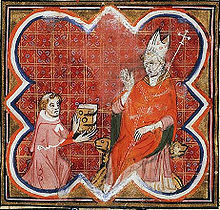You can help expand this article with text translated from the corresponding article in French. (July 2017) Click for important translation instructions.
|

Peter Comestor (Latin: Petrus Comestor, "Peter the Eater"; French: Pierre le Mangeur; died 22 October 1178) was a 12th-century French theological writer and university teacher.
Life
Peter Comestor was born in Troyes. Although the surname Comestor (Latin for "Eater") was popularly attributed to his habit of devouring books and learning, it was more probably simply a family name. It did, however, give Peter a nice pun for his epitaph (supposed to have been composed by him): Petrus eram quem petra tegit, dictusque Comestor nunc comedor ("I whom this stone covers was Peter, called the 'Devourer', now I am devoured").
As a young man, Peter studied at the Troyes Cathedral school, where he might have come into contact with Peter Abelard. Sometime later, he was a student in Paris under, amongst others, Peter Lombard. By 1147, he was back in Troyes, having been appointed dean of Troyes Cathedral. By 1160, Peter had returned to Paris to teach, holding the chair of theology at the university, from which he retired in 1169. He was made chancellor of Notre Dame in Paris around 1164, which put him, among other things, in charge of the cathedral school. He held the post until his death in 1178. Peter's reputation as an academic was such that Pope Alexander III specifically exempted Peter from his ban on charging fees for giving licences to teach.
Peter was buried in the Abbey of Saint Victor. He may have retired and become a canon there, as he was celebrated thus by the canons in their necrology.
Works
Historia Scholastica
Peter's most famous work was his Historia Scholastica: as Beryl Smalley called it, a 'great study of biblical history'. The Historia was completed by 1173, Peter having spent some time writing it at the Abbey of Saint Victor. Peter dedicated it to William, bishop of Sens. The Historia was a core text during the following centuries, even being a source, perhaps, for The Canterbury Tales.
Other works
Many of Peter's works are still unpublished. Among his works are:
- Sermons: 50 are in Migne PL, misattributed to Hildebert of Lavardin (PL clxxi, 330-964, others in PL cxcviii, 1721-1844). The precise number of Peter's sermons is not entirely agreed upon.
- Liber de Sacramentis
- De Poenitentia
- Breviarum Sententiarum
- Glosses on the Gospels, the Glossa Ordinaria, the Psalter, St Paul, and the Twelve Minor Prophets
- Sententiae de Sacramentis, an abridgement of Peter Lombard's Sentences
- Treatises on the Eucharist and on Confession
- Questiones

Editions
- Petri Comestoris Scolastica Historia: Liber Genesis. Edited by Agneta Sylwan. Turnhout: Brepols, 2004, Pp. xc + 227. (Corpus Christianorum Continuatio Mediaevalis, 191). ISBN 978-2503049113
Manuscripts
Historia scholastica
- Épinal, Bibliothèque municipale, ms. 50 s. xiii
- British Library, Harley MS 4132. s. xiii.
- British Library, Egerton MS 272. s. xiii.
- Durham Cathedral, B.III.20. s. xiii.
- Hereford Cathedral, P.v.15. s. xiii in.
- Lincoln Cathedral, 80. s. xii.
- Lincoln Cathedral, 86. s. xiii
Other works
- Hereford Cathedral, O.vii.3. Sermones s. xiii in.
- Oxford, Bodleian Library, MS. Bodley 494. Textus glosatus super Iohannem etc. s. xii/xiii. H.
- Oxford, Bodleian Library, MS. Bodley 748. Petrus Comestor s. xiv.
- Oxford, Corpus Christi College 159. Peter Comestor s. xiv in.
- Lincoln Cathedral, 153. s. xii ex.
- Lincoln Cathedral, 159. s. xiv/xv.
References
- Dalyn, S. R. (1957). "Peter Comestor: Master of Histories". Speculum. 32 (1): 63. doi:10.2307/2849246. JSTOR 2849246. S2CID 162911450.
- Morey, J. H. (1993). "Biblical Paraphrase, and the Medieval Popular Bible" (PDF). Speculum. 68: 10. doi:10.2307/2863832. JSTOR 2863832. S2CID 162846824.
- Dalyn, 64
- Clark, M. (2005). "Peter Comestor and Peter Lombard: Brothers in Deed". Traditio. 60: 85–142. doi:10.1017/S0362152900000246. S2CID 144325543.
- Morey, 10
- Dalyn, 67, 70
- Dalyn, 68
- Smalley, B. (1964). The Study of the Bible in the Middle Ages. University of Notre Dame Press. p. 178.
- Morey, 32-5
- Luscombe, D. (1985). "Peter Comestor". Studies in Church History Subsidia. 4: fn.26. doi:10.1017/S0143045900003598.
Further reading
- M. J. Clark, The Making of the Historia scholastica, 1150–1200 (Studies and Texts, 198), Pontifical Institute of Medieval Studies, 2016 (ISBN 978-0-88844-198-0)
- Gilbert Dahan, Les Intellectuels chrétiens et les Juifs au Moyen Âge, Paris, Cerf, 1990.
- B. Smalley, The Study of the Bible in the Middle Ages, 2nd edn., University of Notre Dame Press, 1964
- D. Luscombe, “The Place of Peter Comestor in the History of Medieval Theology,” in Pierre le Mangeur ou Pierre de Troyes, maître du XIIe siècle, ed. Gilbert Dahan, Brepols, 2013, 27–45
External links
- Works by or about Peter Comestor at the Internet Archive
- Guide to Petrus, Comestor, Historia scholastica. Manuscript, 12-- at the University of Chicago Special Collections Research Center
- Guide to Petrus, Comestor, Historia scholastica. Manuscript, 13-- at the University of Chicago Special Collections Research Center
- Medieval Libraries of Great Britain
- "Pierre le Mangeur"
- "Peter Comestor", Catholic Encyclopedia